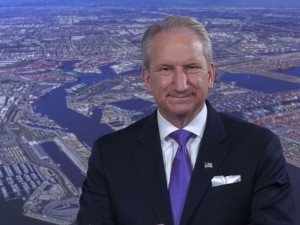The Port of Los Angeles expects “a muted peak season” according to Eugene Seroka, Executive Director, Port of Los Angeles.
Seroka’s prediction comes as the Port reported a decline in July volumes: “July 2023 loaded imports landed at 364,208 TEUs, down 25% compared to the previous year. Loaded exports came in at 110,372 TEUs, an increase of 6% compared to last year. With the need for empty containers in Asia slowing, just 209,710 empty TEUs were processed, a 39% year-over-year decline. Combined, July volumes were 684,291 TEUs, a 27% year-over-year decline. Seven months into 2023, the Port has processed 4,821,670 TEUs, about 24% less than the same period last year.”

Inventory Levels Remain High
Seroka told Bloomberg on August 14th that: “Inventory levels in the United States are still high. The Federal Reserve says that those inventories are at about 1.40 on the inventory sales ratio. That means for every sale you've got about 40% more back in the warehouse. Experts would like to see that at about 10 to 15%. So, we'll see … softer than normal peak season, but the American consumer remains resilient.”
New Ships Push Freight Rates Down
Seroka said that Port of Los Angeles’ volume through the midway point of 2023 is down 23% compared to last year: “And that's really riding on the tails of that inventory that's so high. We're about 12% below the five-year running average. So, we've yet to recover from pre-COVID numbers.”
Labor Disruption Concerns Move Some Cargo To East And Gulf Coasts
Seroka said there was a 15% loss of cargo business caused by the protracted labor negotiations between the International Longshore and Warehouse Union (ILWU) and the Pacific Maritime Association (PMA): “Things will be better, but we also saw a purposeful shift of cargo last year at this time from the West Coast Gateways to the East and Gulf Coast of the United States … there was trepidation about the longshore labor negotiations that became protracted and covered about 13 months … until that tentative agreement was reached back in the middle of June. So, that labor deal's in place.”
However, a final vote on the contract ratification by the ILWU membership has not yet been completed.
Seroka told Bloomberg that some of the cargo that was lost between 2022 to 2023 will not return: “History has shown that some of that cargo will stick to the other coast … but it's my job to go after every … pound of freight possible. We saw that basically 15% of our cargo move to these other gateways during those negotiations. And while there was no strike, there were a couple days there that were a little dicey as we headed toward the completion of that tentative agreement and now it's up to us to bring back that cargo. But it's gonna take an industry push ...”
Over the last twenty years, Seroka said that there has been a decline of market share from 50% to 33% as shippers began to move away from West Coast ports due to increased concerns about labor disruptions: “For the last 20 years, you've seen folks go to a ‘four-corner strategy’ in the United States of port diversification to de-risk what could take place at some of the larger gateways. We've seen market share in Los Angeles dissipate from about 50% of the nation's imports down to 33%, all because of that cargo moving to these other gateways.”
Production Shifts From China Impact Los Angeles
The Port of Los Angeles is also experiencing some losses as a result of companies that have shifted manufacturing away from China: “Fifty-seven percent of the Port of Los Angeles cargo last year was trade with China. That's a high watermark for us that we may not see in the future.”
He added that the recent decline in China’s GDP has “got folks worried … That trade that's been in place for decades will continue though I see a lot more cargo shifting … to Southeast Asia.”
Panama Canal Impact
A spokesman for the Port of Los Angeles does not expect that declines in water levels at the Panama Canal that have caused delays in vessel transits will impact the Port: “We haven’t seen any shift in service to Port of LA yet. That would take some time to reset (vessel) strings. We think that the Suez Canal would be the first to see a bump in activity rather than West Coast ports.”

